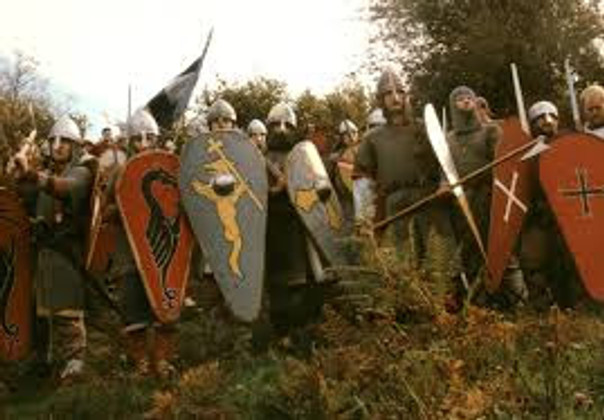Shields of Time
Posted by Sword N Armory on May 31st 2018

On the battlefield there are two options: kill or be killed. As a warrior you’re looking for ways to inflict lethal blows on your enemy while protecting yourself.
Even though proof of shields being used doesn’t start until the Bronze Age, the use of a shield has been around for centuries around the world. An item to protect oneself from the onslaught of another has always been employed. Shields became a part of the armor used for the military, the earliest shield was made of thick wood or woven reeds overlaid with an animal skin, it had a strap attached to the back for either hand or arm usage. A spindle in the middle of the shield would be used instead of a strap and they would place a boss made of iron over the spindle to protect the hand. The back of the shield was concave so the shield could be rested on the soldier's shoulder and relieve his arm from the weight of the shield, some of these shields weighed over 15 lbs.
The Grecian “hoplon” was designed so that when held the larger portion extended over his left side this would assist with covering the other person. The back of the shield was concave the shield could be rested on the soldier's shoulder and relieve his arm from the weight of the shield, some of these shields weighed over 15 lbs. Their shield was fitted with a leather curtain to protect the soldier's legs, due to that length the shield was often times carried sideways, but it still provided some protection, just leaving the legs uncovered.
The Celtic Shield was oval or hexagon in shape they were also made out of wood and covered in leather. These shields used the boss to protect the hand made out of metal. These shields were first used as an offensive strike and then defense, they were considered expendable. Not so of the Grecians, who felt losing your shield was dishonorable.
Roman Shields a “scutum” was mostly made of wood several layers glued together to get its curved shape then covered with linen on the front. With the unique shape and tremendous size they could gather together hold their shields over their heads forming a tortoise type shell this saved many Roman warriors.
Vikings used circular wood shields with an iron boss. Sizes varied greatly due to the consensus that Vikings made their own, to fit their size and style of fighting. The diameter was normally around 35 inches. Gulathing law stated a shield was to be made of wood the spindle was attached with iron nails and there were to be three iron bands on the back of the shield.
American Indian war shield was carried on their arm and used as deflection for objects thrown or shot at them. They were made from the neck skin of buffalo dried and hardened. These were carried by warriors on horseback and were small approximately 20 inches in diameter and very light.
All tribes or kingdoms had their designs, symbols, shapes and colors adorning their shields for recognition and status. Today’s warriors have the same traits concerning being recognizable, where they belong and their ranking. They wear them on their uniform.












